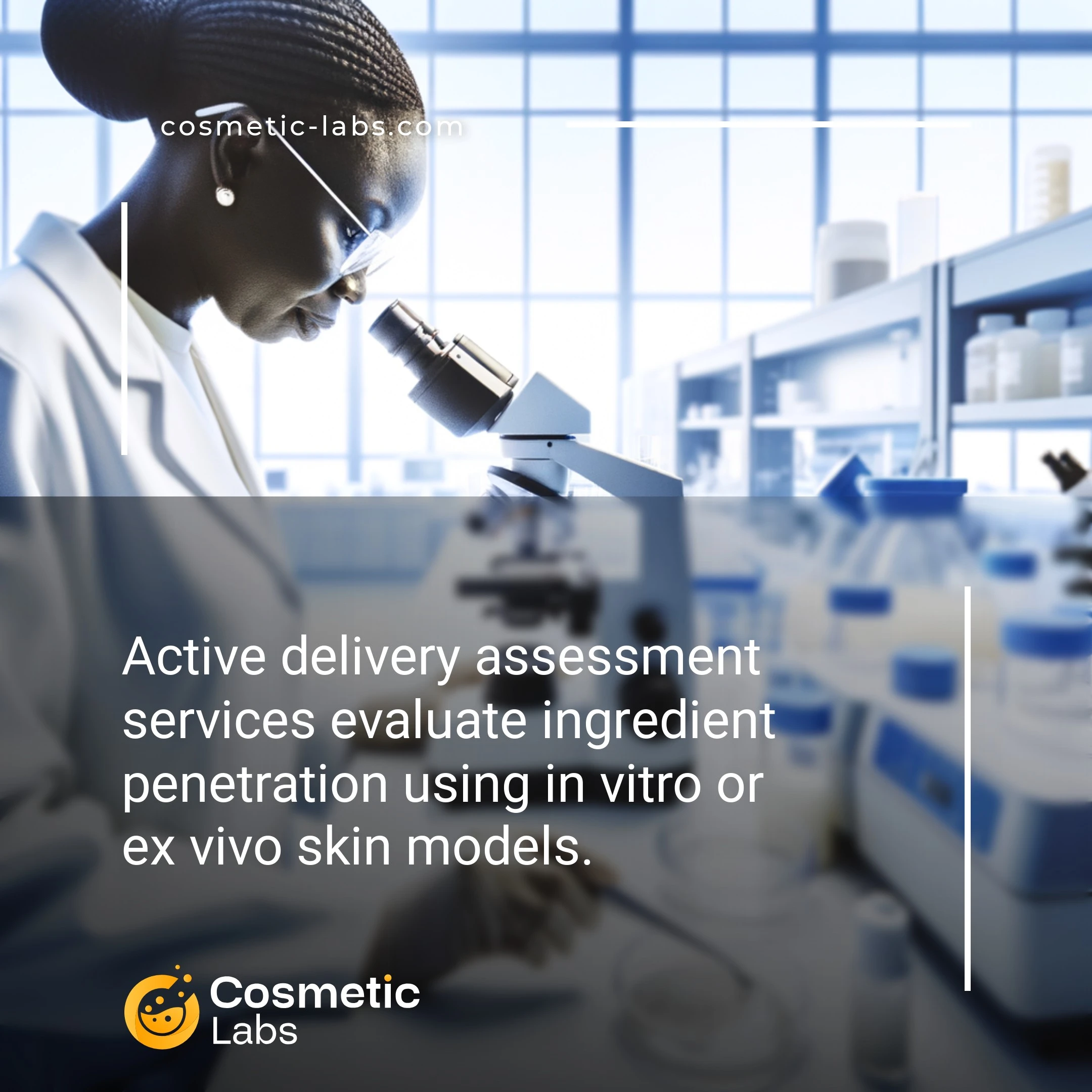Active Delivery Assessment Services for Effective Cosmetic Product Development

What is Active delivery assessment?
Active delivery assessment services measure how well your cosmetic ingredients penetrate skin layers and reach their target sites. These lab tests track ingredient movement through skin barriers using techniques like Franz cell diffusion and tape stripping, showing you exactly where actives go and how much gets absorbed over 24-48 hours. Unlike basic stability tests, delivery assessments reveal actual skin performance, helping you prove claims and optimize formulations before launch.
Why do you need this service?
Cosmetic labs use active delivery assessments to verify that your anti-aging peptides actually reach the dermis rather than sitting on skin’s surface. These specialized tests measure how much of your vitamin C serum penetrates through each skin layer over 24 hours, giving you the data needed to optimize formulations before expensive clinical trials.
Who provides Active delivery assessment services?
All cosmetic labs providing Active delivery assessment services
There is no company providing these services at the moment.
Active Delivery Assessment Services
Active delivery assessment measures how effectively your cosmetic ingredients reach their target sites in the skin. These specialized tests go beyond basic penetration studies by tracking the biological availability and activity of your key ingredients once they’ve crossed the skin barrier.
Performance Testing Methods
Labs use active delivery assessment protocols to verify your product claims. They track ingredient movement through different skin layers using fluorescent markers and advanced imaging techniques.
Standard testing includes:
- Franz cell diffusion studies with active ingredient quantification
- Tape stripping analysis to map ingredient distribution
- Confocal microscopy for real-time penetration tracking
- HPLC analysis to measure active concentrations at target depths
Results show you exactly where ingredients accumulate and whether they maintain their activity after penetration. This data supports marketing claims and helps optimize your formulation.
Bioavailability Verification
Beyond measuring penetration depth, labs assess whether actives remain biologically available once delivered. They test ingredient stability in skin conditions and measure metabolic changes.
Key assessments include:
- Enzyme activity assays in target skin layers
- Antioxidant capacity measurements post-delivery
- Protein binding studies for peptide actives
- pH stability testing at different skin depths
These tests prove your encapsulation technologies or delivery systems actually protect ingredients during transport. Labs provide detailed reports showing bioavailability percentages at specific timepoints, giving you concrete data for product development decisions.
Practical Applications of Active Delivery Assessment in Cosmetic Development
Active delivery assessment provides quantifiable data on how ingredients penetrate skin barriers and reach target layers, directly impacting product efficacy claims and formulation decisions.
Optimizing Anti-Aging Formulations Through Penetration Analysis
Labs use active delivery assessment services to measure how retinoids, peptides, and antioxidants move through skin layers. Franz cell diffusion tests track ingredient concentrations at 2, 6, and 24-hour intervals, revealing absorption rates that guide formulation adjustments.
This data helps formulators select appropriate carrier systems—whether liposomes, microspheres, or polymer matrices—based on measured penetration profiles. Teams adjust pH levels, molecular weights, and vehicle compositions to achieve target delivery rates of 15-40% for most actives.
Validating Natural Extract Performance in Clean Beauty Products
Plant-based actives require rigorous testing to prove skin penetration capabilities. Labs employ tape stripping methods and confocal microscopy to map how botanical compounds like bakuchiol or centella asiatica extracts distribute across epidermis and dermis layers.
Assessment protocols measure both immediate penetration (0-4 hours) and sustained release patterns (up to 72 hours). This quantitative approach transforms marketing claims from “deeply penetrating” to specific measurements like “35% dermal concentration achieved within 8 hours”.
| Assessment Method | Active Types Tested | Typical Timeline | Key Metrics Provided |
|---|---|---|---|
| Franz Cell Diffusion | Vitamins, acids, peptides | 24-48 hours | Flux rate, cumulative absorption % |
| Tape Stripping Analysis | Moisturizers, sunscreens | 2-8 hours | Layer-by-layer concentration |
| Confocal Raman Spectroscopy | Retinoids, niacinamide | Real-time to 24 hours | 3D penetration mapping |
| Microdialysis Studies | Anti-inflammatories | 6-72 hours | Bioavailability in dermis |
Ready to validate your active ingredients’ delivery performance? Connect with specialized cosmetic labs on our platform that offer comprehensive penetration testing protocols tailored to your formulation needs.
